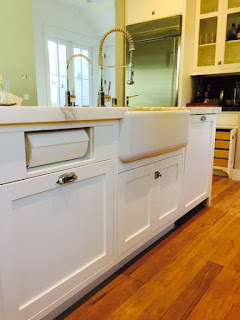10 Principles of Organizing That Work in Every Room
by Laura Gaskill
Feeling overwhelmed by
your stuff? Here’s how to
make your things more findable and easier to put away
Getting your home organized is a great feeling, but figuring out
where to start can be overwhelming. Keep the process simple by zeroing in on
these 10 principles of organizing, which can be applied to any space, anytime.
1. Get to know active vs. passive zones. Active zones are the spots in your home
that you pass or touch daily (usually multiple times a day), and include the
entryway, top drawers and eye-level shelves and cabinets.
Passive zones are the less frequently used spaces in your home, including the guest room, garage or basement, very high and very low shelves, and nooks deep within closets.
A common organizing mistake is to clutter your prime active zones with items you don’t frequently need. For example: Don’t keep your spare lightbulbs in the top drawer in the kitchen when you only need to grab one every few months!
Passive zones are the less frequently used spaces in your home, including the guest room, garage or basement, very high and very low shelves, and nooks deep within closets.
A common organizing mistake is to clutter your prime active zones with items you don’t frequently need. For example: Don’t keep your spare lightbulbs in the top drawer in the kitchen when you only need to grab one every few months!
2. Make open storage beautiful. Every home can use a combination of open
and closed (i.e., hidden) storage. But what you choose to store on your open
shelving should be visually pleasing. In the living room, this is a good place
for books (arranged by color if you’re feeling artsy) and pretty objects, not
beaten-up board games and stacks of video games. Likewise in the kitchen, open
shelving is the place to put your matching sets of clear drinking glasses or
favorite teacups, not the plastic food storage containers.
3. Keep things findable. Out of sight, out of mind is an especially apt expression when it
comes to organizing. Clear containers are ideal when you want to be able to see
the contents at a glance, and open baskets can corral loose items while still
letting you look inside.
If you use containers that aren’t transparent, be sure to label them clearly — or take it a step further and label each with a photo of the objects inside. (Instant cameras are ideal for this.)
If you use containers that aren’t transparent, be sure to label them clearly — or take it a step further and label each with a photo of the objects inside. (Instant cameras are ideal for this.)
4. Make it easy to put
away. This is most important when
it comes to kid stuff, but we can all benefit from this rule.
When you need to go get something, you’ll get it out — it doesn’t really matter where it is— but when it’s time to clean up, we all get a little lazy.
To increase the likelihood of stuff being put back in its place, use easy-to-access bins, baskets and hampers, simple filing systems, and wall hooks for frequently used items.
When you need to go get something, you’ll get it out — it doesn’t really matter where it is— but when it’s time to clean up, we all get a little lazy.
To increase the likelihood of stuff being put back in its place, use easy-to-access bins, baskets and hampers, simple filing systems, and wall hooks for frequently used items.
5. Group by task. I think of this as the first-aid kit phenomenon: When you
need a Band-Aid, you may also need some antibiotic ointment, maybe some
tweezers to remove a splinter, and a gauze pad; in a first-aid kit, everything
you need to complete the task of caring for your injury is conveniently located
in one place.
When you’re organizing your stuff, remember this and group everything you need to complete a task in the same place.
For example, you could make one box for medications, another for spare office supplies, one for holiday cookie cutters and sprinkles, and so on. Labeled shoebox-size boxes (like the ones shown here) work well for grouping small items together.
When you’re organizing your stuff, remember this and group everything you need to complete a task in the same place.
For example, you could make one box for medications, another for spare office supplies, one for holiday cookie cutters and sprinkles, and so on. Labeled shoebox-size boxes (like the ones shown here) work well for grouping small items together.
6. Create a way station for
items in transit. We
all have a certain amount of stuff that’s constantly in transit: library books
waiting to be returned, our bag and keys, the dog’s leash, the casserole dish a
friend left after your last party.
Instead of allowing these random items to pile up, create a dedicated space that can handle them and keep them neat.
If you have room by the main entrance to your home, this is the most logical spot — a few baskets on a shelf and some wall hooks should do the trick.
Instead of allowing these random items to pile up, create a dedicated space that can handle them and keep them neat.
If you have room by the main entrance to your home, this is the most logical spot — a few baskets on a shelf and some wall hooks should do the trick.
7. Subdivide and conquer. Wide-open drawers are an invitation to
clutter. Anytime you have a drawer where you’ll be storing small items, use a
drawer organizer. Use them for cutlery in the kitchen, office supplies in your
desk, small and useful household items in your junk drawer, and daily
essentials (sunglasses, keys) in a drawer near the entry.
8. Go vertical. What happens when you go for something at the bottom of a
pile? That’s right, it topples.
Avoid this organizing nightmare and go vertical instead. Use shelf risers to increase cabinet capacity, store sheet pans and trays in a vertical holder, and use wall-mounted holders to store brooms and mops so they won’t tip over.
Avoid this organizing nightmare and go vertical instead. Use shelf risers to increase cabinet capacity, store sheet pans and trays in a vertical holder, and use wall-mounted holders to store brooms and mops so they won’t tip over.
9. Choose the right container for the job. It can be heartbreaking to find that some of
your most precious items — old family photographs, Grandma’s wedding
gown — have been ruined thanks to improper storage.
Take preventative measures by choosing the right storage container for the job. Photographs and paper memorabilia should be stored in acid-free containers or albums, and textiles should be kept in breathable storage boxes or bags designed for that purpose.
Take preventative measures by choosing the right storage container for the job. Photographs and paper memorabilia should be stored in acid-free containers or albums, and textiles should be kept in breathable storage boxes or bags designed for that purpose.
10. Store heavy items down
low.You should never have to
balance on a stepladder while trying to lift something heavy.
Keep heavy items at or below waist height, including boxes, kitchen equipment (those dutch ovens and stand mixers weigh a ton!) and anything else that takes some real effort to lift.
And if you live in earthquake country, this is doubly important: You don’t want heavy items falling out of high cupboards and landing on someone’s head.
Keep heavy items at or below waist height, including boxes, kitchen equipment (those dutch ovens and stand mixers weigh a ton!) and anything else that takes some real effort to lift.
And if you live in earthquake country, this is doubly important: You don’t want heavy items falling out of high cupboards and landing on someone’s head.
Need storage ideas for your projects? Cabinet-S-Top can assist you with that. Stop by our showroom located at 1977 Medina Road, Medina, OH 44256 to get started. 330.239.3630 ~ www.cabinet-s-top.com












Comments
Post a Comment